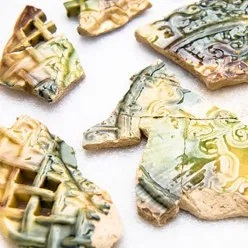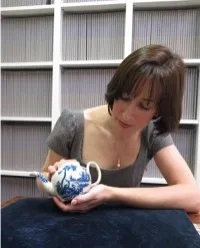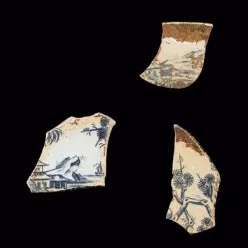Recent Discoveries in American Ceramics
An “Antiques Roadshow” moment has turned into one of the most exciting discoveries in the field of American ceramics in recent years.

Teapot, attr. John Bartlam, soft-paste porcelain, c. 1770, Cain Hoy, SC, USA. Photo courtesy of Woolley and Wallis.
Last year, an antiques collector spotted an intriguing blue and white teapot at an antiques fair. Intrigued by the form and pattern, he snapped it up for £15 (about $21.50), despite the fact that it was missing its lid and had a significant repair to the handle. The transfer-printed decoration is different on the two sides, but the most significant is one depicting two cranes under a palmetto, with two small watercraft in the background. Some research by the collector matched the pattern to a set of blue and white tea bowls and saucers attributed to John Bartlam, an English Potter who immigrated to South Carolina. His suspicions were confirmed by the English auction house Woolley and Wallis, out of Salisbury, who will be selling the teapot on February 20. The conservative sale estimate is £10,000-£20,000.
The European quest to discover the manufacturing secrets behind true hard-paste porcelain has been a seminal point in the history of western decorative arts for as long as people have collected. Not to be left behind, a small number 18th-century American potters began to produce fine cream-colored earthenware and investigate sources for soft-paste porcelain of sufficient quality that Josiah Wedgewood worried they might begin to compete. Fortunately for him, the North American manufacturers did not truly take off until later in the 19th century.
Long regarded as a minor figure on the ceramics scene, the Staffordshire immigrant John Bartlam settled in South Carolina at Cain Hoy, near Charleston, and produced slipware, creamware, and pearlware between 1763 and 1772. Intriguingly, in 1770 he advertised his workshop “a China Manufactory and Pottery.” This differentiation puzzled scholars, who had thus far only identified “Carolina Creamware,” a fine earthenware that, while not as pale as its English counterparts, often rivaled the British goods in terms of execution and decoration.
Archaeological excavations around Cain Hoy began in the 1960s, but significant excavations in 1991 and 1992 revealed large quantities of blue and white sherds which was cautiously labeled “proto pearlware.” It was not until 2006-07, when further analysis was performed by Lisa Hudgins, that examples were scientifically confirmed Bartlam pottery examples as true soft-paste porcelain. This astonishing finding made Bartlam the earliest known producer of porcelain in North America, beating the Philadelphia firm of Bonnin and Morris by several years. The blue and white sherds matched the pattern on a set of tea bowls and saucers that came to auction in 2011, previously attributed to Joseph Shore’s Isleworth Pottery in England. In addition to being an important addition to Bartlam’s known oeuvre, this teapot is now the earliest extant American porcelain example of its form.
Cream colored earthenware fragments from the Bartlam pottery site at Cain Hoy. Image courtesy of The Charleston Museum.
Blue and white ceramic sherds from the Bartlam Pottery site, Cain Hoy, SC. Image courtesy of Chipstone.
Clare Durham, the ceramics specialist of Woolley and Wallis, said the final price of the teapot “could make six figures… In theory this teapot should be more valuable as it is a major part of the Bartlam tea service. Most of the six other Bartlam pieces are in museums in America now.”
We look forward to following this auction! For those interested in learning more about the material culture of early South Carolina, please stay tuned for registration information for our upcoming one-day symposium at Drayton Hall, “An Agreeable Prospect: Rediscovering Drayton Hall in the 18th-century Atlantic World,” which will be held on September 15, 2018!
About The Decorative Arts Trust Bulletin
Formerly known as the "blog,” the Bulletin features new research and scholarship, travelogues, book reviews, and museum and gallery exhibitions. The Bulletin complements The Magazine of the Decorative Arts Trust, our biannual members publication.











